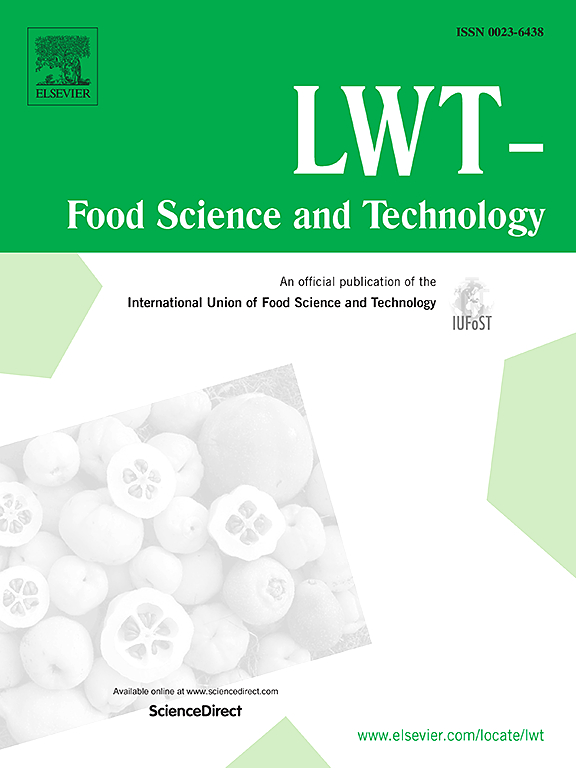l -半胱氨酸和l -蛋氨酸通过减少果实腐烂和保持采后果实品质来保存草莓
IF 6.6
1区 农林科学
Q1 FOOD SCIENCE & TECHNOLOGY
引用次数: 0
摘要
研究了外源l -半胱氨酸(L-Cys)和l -蛋氨酸(L-Met)对草莓‘Benihoppe’和‘Fenyu 1号’采后品质保鲜和保质期延长的影响。用不同浓度(L-Cys为0.01 - 0.2%,L-Met为0.5-100 mM)处理果实,并在控制条件下保存。结果表明,与对照组相比,0.1% L-Cys和50 mM L-Met分别使体重减轻16.3%和40.4%,龋齿发生率分别降低24.5%和35%。两种处理均维持较高的抗坏血酸(AsA)水平,其中L-Met更有效,同时对酚类代谢有差异调节。L-Cys使总酚含量增加42%,但抑制花青素含量。高效液相色谱(HPLC)分析显示,l -半胱氨酸对有机酸的影响具有品种特异性:l -半胱氨酸使‘Benihoppe’的柠檬酸含量增加23.5%,而两种氨基酸都使‘Fenyu 1号’的柠檬酸含量减少。氧化应激标志物表现出品种依赖性,L-Cys和L-Met降低丙二醛(MDA) 18 - 27%,但有时会增加过氧化氢(H2O2)。L-Met保存了抗氧化酶活性,维持超氧化物歧化酶(SOD)比对照高18 - 22%,过氧化氢酶(CAT)保持稳定。这些发现强调了含硫氨基酸(SAAs)在草莓质量保存中的作用,并支持L-Cys和L-Met作为草莓传统防腐剂的安全有效替代品。本文章由计算机程序翻译,如有差异,请以英文原文为准。
L-cysteine and L-methionine application preserve strawberries by reducing fruit decay and maintaining postharvest fruit quality
This study investigated the efficacy of exogenous L-cysteine (L-Cys) and L-methionine (L-Met) in preserving postharvest quality and extending shelf life of strawberry cultivars ‘Benihoppe’ and ‘Fenyu No.1’. Fruits were treated with varying concentrations (L-Cys at 0.01–0.2 % and L-Met at 0.5–100 mM) and stored under controlled conditions. Results showed that 0.1 % L-Cys and 50 mM L-Met optimally reduced weight loss by 16.3 % and 40.4 %, respectively, and decay incidence by 24.5 % and 35 % compared to controls. Both treatments maintained higher ascorbic acid (AsA) levels, with L-Met being more effective, while differentially modulating phenolic metabolism. L-Cys increased total phenolic content by up to 42 % but suppressed anthocyanins. High-performance liquid chromatography (HPLC) analysis revealed cultivar-specific effects on organic acids: L-Cys increased citric acid by 23.5 % in ‘Benihoppe’, whereas both amino acids reduced it in ‘Fenyu No.1’. Oxidative stress markers exhibited cultivar-dependent responses, with L-Cys and L-Met reducing malondialdehyde (MDA) by 18–27 % but sometimes increasing hydrogen peroxide (H2O2). L-Met preserved antioxidant enzyme activity, maintaining superoxide dismutase (SOD) 18–22 % higher than the control, while catalase (CAT) remained stable. These findings highlight the role of sulfur-containing amino acids (SAAs) in quality preservation, and supports L-Cys and L-Met as safe, effective alternatives to traditional preservatives for strawberries.
求助全文
通过发布文献求助,成功后即可免费获取论文全文。
去求助
来源期刊

LWT - Food Science and Technology
工程技术-食品科技
CiteScore
11.80
自引率
6.70%
发文量
1724
审稿时长
65 days
期刊介绍:
LWT - Food Science and Technology is an international journal that publishes innovative papers in the fields of food chemistry, biochemistry, microbiology, technology and nutrition. The work described should be innovative either in the approach or in the methods used. The significance of the results either for the science community or for the food industry must also be specified. Contributions written in English are welcomed in the form of review articles, short reviews, research papers, and research notes. Papers featuring animal trials and cell cultures are outside the scope of the journal and will not be considered for publication.
 求助内容:
求助内容: 应助结果提醒方式:
应助结果提醒方式:


